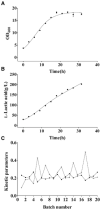Kinetic characteristics of long-term repeated fed-batch (LtRFb) l-lactic acid fermentation by a Bacillus coagulans strain
- PMID: 33304229
- PMCID: PMC7708950
- DOI: 10.1002/elsc.202000043
Kinetic characteristics of long-term repeated fed-batch (LtRFb) l-lactic acid fermentation by a Bacillus coagulans strain
Abstract
Application of degradable plastics is the most critical solution to plastic pollution. As the precursor of biodegradable plastic PLA (polylactic acid), efficient production of l-lactic acid is vital for the commercial replacement of traditional plastics. Bacillus coagulans H-2, a robust strain, was investigated for effective production of l-lactic acid using long-term repeated fed-batch (LtRFb) fermentation. Kinetic characteristics of l-lactic acid fermentation were analyzed by two models, showing that cell-growth coupled production gradually replaces cell-maintenance coupled production during fermentation. With the LtRFb strategy, l-lactic acid was produced at a high final concentration of 192.7 g/L, on average, and a yield of up to 93.0% during 20 batches of repeated fermentation within 487.5 h. Thus, strain H-2 can be used in the industrial production of l-lactic acid with optimization based on kinetic modeling.
Keywords: Bacillus coagulans; Kinetics; Long‐term repeated fed‐batch; l‐Lactic acid.
© 2020 The Authors. Engineering in Life Sciences published by Wiley‐VCH GmbH.
Conflict of interest statement
The authors have declared no conflict of interest.
Figures






Similar articles
-
High-titer and productivity of l-(+)-lactic acid using exponential fed-batch fermentation with Bacillus coagulans arr4, a new thermotolerant bacterial strain.3 Biotech. 2018 Apr;8(4):213. doi: 10.1007/s13205-018-1232-0. Epub 2018 Apr 7. 3 Biotech. 2018. PMID: 29651378 Free PMC article.
-
Non-sterilized fermentation of high optically pure D-lactic acid by a genetically modified thermophilic Bacillus coagulans strain.Microb Cell Fact. 2017 Nov 25;16(1):213. doi: 10.1186/s12934-017-0827-1. Microb Cell Fact. 2017. PMID: 29178877 Free PMC article.
-
L: (+)-Lactic acid production from non-food carbohydrates by thermotolerant Bacillus coagulans.J Ind Microbiol Biotechnol. 2011 May;38(5):599-605. doi: 10.1007/s10295-010-0796-4. Epub 2010 Aug 9. J Ind Microbiol Biotechnol. 2011. PMID: 20694852
-
Non-sterilized fermentative production of polymer-grade L-lactic acid by a newly isolated thermophilic strain Bacillus sp. 2-6.PLoS One. 2009;4(2):e4359. doi: 10.1371/journal.pone.0004359. Epub 2009 Feb 4. PLoS One. 2009. PMID: 19194504 Free PMC article.
-
Production of lactic acid from paper sludge by simultaneous saccharification and fermentation.Adv Biochem Eng Biotechnol. 2004;87:173-94. doi: 10.1007/b94365. Adv Biochem Eng Biotechnol. 2004. PMID: 15217107 Review.
Cited by
-
Low acyl gellan gum immobilized Lactobacillus bulgaricus T15 produce D-lactic acid from non-detoxified corn stover hydrolysate.Biotechnol Biofuels Bioprod. 2023 Mar 13;16(1):43. doi: 10.1186/s13068-023-02292-5. Biotechnol Biofuels Bioprod. 2023. PMID: 36915198 Free PMC article.
References
-
- Abdel‐Rahman, M. A. , Tashiro, Y. , Sonomoto, K. , Recent advances in lactic acid production by microbial fermentation processes. Biotechnol. Adv. 2013, 31, 877–902. - PubMed
-
- Fukushima, K. , Chang, Y. H. , Kimura, Y. , Enhanced stereocomplex formation of poly(l‐lactic acid) and poly(d‐lactic acid) in the presence of stereoblock poly(lactic acid). Macromol. Biosci. 2007, 7, 829–835. - PubMed
-
- Han, X. , Huang, K. , Tang, H. , Ni, J. et al., Steps toward high‐performance PLA: economical production of d‐lactate enabled by a newly isolated Sporolactobacillus terrae strain . Biotechnol. J. 2019, 14, e1800656. - PubMed
LinkOut - more resources
Full Text Sources
Other Literature Sources
Research Materials
